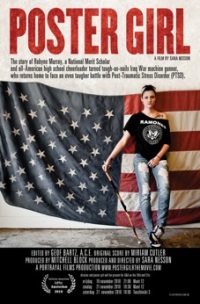
Poster Girl is the story of Robynn Murray, an all-American high school cheerleader turned “poster girl” for women in combat, distinguished by Army Magazine’s cover shot. Now home from Iraq, her tough-as-nails exterior begins to crack, leaving Robynn struggling with the debilitation effects of PTSD and the challenges of rebuilding her life. Directed by Sara Nesson.
Robynn Murray’s trauma was palpable. Her anxiety came through in her near-constant breathlessness, emotional breakdowns, and outbursts of anger. Although she had enrolled in the division of the army sent in after combat missions–to rebuild and ‘win hearts and minds’–she was sent directly into combat. Although women are officially forbidden to participate in combat in the US military, most people will acknowledge that the distinction between combat and non-combat roles is archaic and even non-existent in 21st century war zones. That Murray was assigned a gunner position atop a tank (the most dangerous, exposed position) on the second day of her tour of duty in Iraq shouldn’t surprise the realists among us, but is nevertheless shocking when told from a raw, personal perspective.
Rooting for this film (and, in turn, rooting for its star and director) is enough to make me excited for next weekend’s Oscar ceremony.
Watching Poster Girl was by far the highlight of my experience at the Athena Film Festival. Not only is it a convincing portrayal of the serious effects of post-traumatic stress disorder, but it’s a subtle anti-war film, one that illustrates the often disastrous consequences of repeated exposure to death and violence–and not just for women in combat. Nesson gets moving footage of several former soldiers, including Robynn, who create art from their uniforms, and the soldiers all emphasize the healing power of that process. (I personally loved watching each of them rip their uniforms to shreds.)
Nesson also juxtaposes photos of Robynn prior to her Army experience–where she’s in a cheerleading uniform, smiling and having fun with friends–with the post-Army Robynn, a tattooed, pierced, PTSD victim who stares at the former photos as if they couldn’t possibly be her. And they aren’t anymore. The new Robynn is an activist who speaks out against war and gun violence, even while dealing with debilitating panic attacks.
The film shows just how screwed up our system is for soldiers returning from service: it’s heartbreaking to watch Robynn practically beg for the disability checks the government owes her, as well as witness the lengths she has to go to to “prove” that she’s disabled. But even after all this, Poster Girl somehow ends on a hopeful note, with a smile from Robynn that we hadn’t seen since before she entered the Army.
Watch the preview:
